
Thresholds
Scope & Guideline
Navigating the Complexities of a Technologically Mediated World
Introduction
Aims and Scopes
- Interdisciplinary Exploration of Architecture:
The journal emphasizes the need for a multi-faceted approach to architecture that incorporates perspectives from various disciplines, including art, sociology, and environmental studies. - Focus on Disappearance and Transformation:
A consistent theme in recent publications is the exploration of disappearance—whether of cultural identities, architectural forms, or landscapes—reflecting on how these transformations impact human experience and memory. - Engagement with Climate and Environmental Issues:
The journal addresses pressing climate-related challenges, investigating how architectural practices can respond to and reflect upon environmental transformations and human adaptation. - Cultural Narratives and Historical Contexts:
'Thresholds' seeks to uncover the historical narratives embedded in architecture and landscapes, often revisiting past events to inform contemporary discourse. - Artistic and Theoretical Approaches:
The journal encourages innovative artistic interpretations and theoretical frameworks to analyze and critique architectural and spatial practices, fostering a dialogue between theory and practice.
Trending and Emerging
- Hauntology and Memory:
The exploration of hauntological themes—focusing on memory, loss, and the spectral presence of the past—has emerged as a significant focus, reflecting a growing interest in how these concepts shape our understanding of space. - Climate Resilience and Adaptation:
Recent articles increasingly emphasize the role of architecture in addressing climate change and resilience, highlighting adaptive design strategies and the socio-political implications of environmental transformations. - Cultural Deconstruction and Re-imagination:
There is a rising trend towards deconstructing cultural narratives and re-imagining spaces, particularly in relation to colonial histories and marginalized communities, which seeks to challenge dominant discourses. - Technological Interventions in Architecture:
The integration of technology in architectural practices is gaining prominence, with discussions surrounding digital tools and their impact on design processes and spatial experiences. - Interrogation of Public Spaces:
The journal is increasingly focusing on the role of public spaces in societal interactions, particularly in the context of urbanization and community engagement, reflecting a commitment to social justice and inclusivity.
Declining or Waning
- Traditional Architectural Theory:
There appears to be a waning focus on established architectural theories that do not incorporate contemporary socio-political issues, as the journal shifts towards more dynamic and critical approaches. - Static Representations of Space:
The journal has moved away from static depictions of space and architecture, favoring narratives that express transformation and fluidity, which has led to a reduction in articles that simply describe built environments without critical analysis. - Historical Preservation without Contextualization:
While historical perspectives remain important, there has been a shift away from merely preserving historical narratives in architecture towards a more critical engagement that connects history with current socio-political realities. - Conventional Aesthetic Discourses:
There is a noticeable decline in discussions centered around conventional aesthetics in architecture, as the journal embraces more experimental and conceptual practices that challenge traditional beauty norms.
Similar Journals

MESTER
Bridging Cultures Through Scholarly ExplorationMESTER is a distinguished academic journal published by the UCLA College of Humanities, known for its commitment to advancing research in the fields of Cultural Studies, Linguistics and Language, and Literature and Literary Theory. With an ISSN of 0160-2764, this journal serves as a vital platform for scholars and professionals to disseminate innovative research and critical perspectives from diverse theoretical frameworks and cultural contexts. Although currently operating without an Open Access model, MESTER continues to uphold a rigorous peer-review process, ensuring that published articles maintain high academic standards. Recognized for its selective focus, MESTER holds a Q4 categorization in Cultural Studies and Linguistics, and Q3 in Literature and Literary Theory, situating it as a relevant, if emerging, voice within these disciplines. Housed within the significant repository of knowledge at UCLA, the journal beckons researchers, students, and practitioners to engage with its contributions to the humanities and build upon its foundations in cultural discourse.
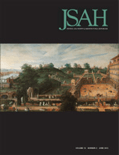
JOURNAL OF THE SOCIETY OF ARCHITECTURAL HISTORIANS
Bridging History and Modernity in Architectural StudiesJOURNAL OF THE SOCIETY OF ARCHITECTURAL HISTORIANS, published by the SOCIETY OF ARCHITECTURAL HISTORIANS, serves as a premier platform for the dissemination of scholarly research and critical discourse in the fields of architecture and architectural history. Established in 1970, this journal has undergone significant evolution, focusing on interdisciplinary studies that explore architectural heritage, theory, and practice. With a current impact factor that places it within the Q2 category in both History and Visual Arts and Performing Arts, as well as Q3 in Architecture, the journal maintains a robust reputation among academics and professionals alike. Although it operates under traditional access models, its essential role in fostering a deep understanding of architectural narratives and their socio-cultural contexts remains unparalleled. The journal also ranks favorably in Scopus, highlighting its importance in the arts and humanities, as well as engineering disciplines related to architecture. By bridging the gap between historical inquiry and contemporary architectural criticism, the JOURNAL OF THE SOCIETY OF ARCHITECTURAL HISTORIANS continues to be a vital resource for researchers, professionals, and students endeavoring to enrich their knowledge and contribute to this dynamic field.

Architecture and Culture
Advancing Interdisciplinary Insights in Built EnvironmentsArchitecture and Culture is an esteemed journal published by Routledge Journals, Taylor & Francis Ltd, focusing on the intersection of architecture, cultural studies, urbanism, and the visual and performing arts. Since its inception, this journal has become a vital platform for researchers, professionals, and students to explore the multifaceted relationship between architecture and cultural identity within contemporary contexts. With an ISSN of 2050-7828 and an E-ISSN of 2050-7836, the journal reaches a global audience from its base in the United Kingdom. Featuring a commendable Q2 ranking in Visual Arts and Performing Arts and a consistent presence in multiple relevant quartiles, including Q3 in both Architecture and Cultural Studies, it is well-regarded for its scholarly impact. The journal offers a unique opportunity for interdisciplinary dialogue, fostering innovative research that examines how built environments shape and are shaped by cultural narratives. This commitment to advancing knowledge in these fields is reflected in its ongoing publication from 2014 to 2024, making it a pivotal resource for those at the forefront of the discourse on architecture and culture.
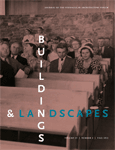
Buildings & Landscapes-Journal of the Vernacular Architecture Forum
Navigating the Landscape of Cultural IdentityBuildings & Landscapes: Journal of the Vernacular Architecture Forum is a pivotal scholarly publication that delves into the intersection of architecture, urban studies, and the arts. Published by University of Minnesota Press, this journal serves as a vital platform for the exploration and dissemination of research covering the rich tapestry of vernacular architecture and its implications in contemporary society. With its ISSN 1936-0886 and E-ISSN 1934-6832, the journal has established its significance, reflected by its notable quartile rankings in 2023, including Q4 in Architecture and Urban Studies, and Q3 in Visual Arts and Performing Arts. Although not open access, it remains an essential resource for researchers, professionals, and students looking to deepen their understanding of how built environments shape cultural identities and vice versa. The journal welcomes contributions that critically examine the role of vernacular architecture in both historical and modern contexts, making it an influential beacon of knowledge from its establishment in 2010 to the present. For those invested in the dialogue surrounding place, culture, and architecture, Buildings & Landscapes offers a unique and scholarly avenue for inquiry.
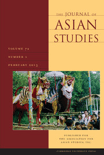
JOURNAL OF ASIAN STUDIES
Delving Deep into the Heart of Asian StudiesJOURNAL OF ASIAN STUDIES, published by DUKE UNIVERSITY PRESS, is a premier academic journal dedicated to the exploration of Asian cultures, histories, and societies. With its roots tracing back to 1941, this journal has consistently provided a platform for high-quality scholarship, achieving a distinguished impact factor that places it in the top quartile (Q1) in both Cultural Studies and History as of 2023. The journal ranks impressively in Scopus, holding the #51 position in the History category and #111 in Cultural Studies, reflecting its influence and reputation among scholars around the globe. Although not an open-access publication, it remains vital for researchers, professionals, and students seeking in-depth analyses and discussions about Asia's multifaceted narratives and contemporary issues. By bridging disciplinary divides and fostering interdisciplinary dialogue, the JOURNAL OF ASIAN STUDIES is an essential resource for anyone looking to enrich their understanding of the Asian continent and its global implications.

Bagh-e Nazar
Exploring the Intersection of Art and UrbanismBagh-e Nazar is a distinguished academic journal dedicated to the fields of art, architecture, and urbanism, published by the NAZAR RESEARCH CENTER in Tehran, Iran. With a focus on promoting scholarly research and innovative ideas, this journal serves as a platform for critical discussions and diverse perspectives on contemporary artistic and architectural practices. The journal is indexed under ISSN 1735-9635 and E-ISSN 2251-7197, reflecting its commitment to high academic standards and international visibility. Although currently not open access, it seeks to provide comprehensive insight into the socio-cultural dynamics influencing urban environments and artistic expressions. By bridging theory and practice, Bagh-e Nazar plays a pivotal role in advancing knowledge and fostering dialogue within the vibrant domains of art and architecture, making it an invaluable resource for researchers, professionals, and students alike.
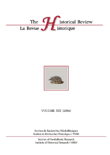
Historical Review-La Revue Historique
Unveiling the Past, Shaping the Future.Historical Review-La Revue Historique, published by the NATL HELLENIC RES FOUNDATION, is a premier open-access journal focusing on the multifaceted field of history. Established in 2004 and operating out of Greece, this journal serves as a platform for the dissemination of scholarly research, critical essays, and innovative perspectives on historical events, figures, and themes. Though it has transitioned through different stages in its indexing, including a hiatus from Scopus coverage between 2009 to 2021, it has successfully maintained its presence in the academic community, evidenced by its current Q4 classification in the history category of Arts and Humanities. With an ISSN of 1790-3572 and an E-ISSN of 1791-7603, the journal continues to foster rich academic dialogue and inquiry, making research accessible to a wider audience. As a valuable resource for researchers, educators, and students, Historical Review-La Revue Historique contributes significantly to the understanding and appreciation of historical narratives and methodologies.
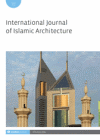
International Journal of Islamic Architecture
Exploring the Essence of Islamic Architectural HeritageThe International Journal of Islamic Architecture, published by INTELLECT LTD in the United Kingdom, is a pivotal scholarly resource dedicated to the exploration of Islamic architecture, design, and cultural expressions within a contemporary framework. With ISSN 2045-5895 and E-ISSN 2045-5909, this journal targets an interdisciplinary audience by bridging the gap between architecture, geography, urban studies, and the arts. Established in 2012, it has swiftly garnered recognition, achieving notable rankings such as Q3 in Architecture and Q2 in Visual Arts and Performing Arts by 2023. Although it currently does not offer open access, its articles are meticulously peer-reviewed, ensuring high academic standards and relevance. Emphasizing the significance of Islamic architectural heritage in global contexts, the journal seeks to foster innovative perspectives and critical discourse, making it an essential platform for researchers, professionals, and students alike to engage with contemporary architectural practices and cultural dialogues.
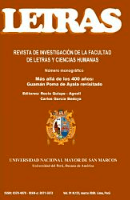
Letras-Lima
Empowering research in the heart of Peru.Letras-Lima is a prestigious open-access journal published by the Universidad Nacional Mayor de San Marcos in Peru, dedicated to advancing the fields of Arts and Humanities, Cultural Studies, Linguistics, and Literature. Since its transition to open access in 2003, it has established itself as a vital resource for scholars and practitioners alike, aiming to foster intellectual discourse and cultural exchange across disciplines. The journal boasts a commendable impact factor, with a range of Q2 to Q4 quartiles within its respective categories for 2023, reflecting its commitment to quality and relevance. Notably, it holds a significant role in promoting literature and literary theory, currently ranking 240 out of 1,106 in the category, indicating it occupies the 78th percentile of publications in its field. Addressing the complexities and nuances of language and culture, Letras-Lima serves as an essential platform for researchers, professionals, and students seeking to disseminate and engage with transformative ideas that shape our understanding of society and identity.
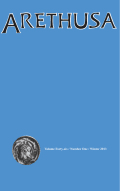
ARETHUSA
Cultivating Critical Analysis in the HumanitiesARETHUSA, published by the Johns Hopkins University Press, is a prestigious journal that aims to foster dialogue and scholarship in the fields of Classics, Cultural Studies, and Literature and Literary Theory. Since its inception, it has been recognized for its profound impact on academic research, reflected in its Q2 rankings across multiple categories. With an ISSN of 0004-0975 and an E-ISSN of 1080-6504, ARETHUSA embraces a comprehensive scope that encourages innovative discourse and critical analysis from 1974 through to 2024. Although the journal does not offer open access, its rigorous selection process ensures that only the highest quality research is published, making it a vital resource for scholars, professionals, and students dedicated to advancing knowledge in these interconnected disciplines. The journal's commitment to excellence is further demonstrated by its standing in various Scopus rankings, reinforcing its significance in the scholarly community.